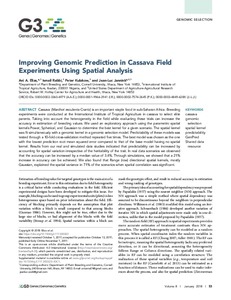| dc.contributor.author | Elias, A.A. |
| dc.contributor.author | Rabbi, Ismail Y |
| dc.contributor.author | Kulakow, P.A. |
| dc.contributor.author | Jannink, Jean-Luc |
| dc.date.accessioned | 2019-12-04T11:11:17Z |
| dc.date.available | 2019-12-04T11:11:17Z |
| dc.date.issued | 2017 |
| dc.identifier.citation | Elias, A.A., Rabbi, I., Kulakow, P. & Jannink, J.L. (2017). Improving genomic prediction in cassava field experiments using spatial analysis. G3: Genes, Genomes, Genetics, 1-14. |
| dc.identifier.issn | 2160-1836 |
| dc.identifier.uri | https://hdl.handle.net/20.500.12478/2394 |
| dc.description | Published online: 07 Nov 2017 |
| dc.description.abstract | Cassava (Manihot esculenta Crantz) is an important staple food in sub-Saharan Africa. Breeding experiments were conducted at the International Institute of Tropical Agriculture in cassava to select elite parents. Taking into account the heterogeneity in the field while evaluating these trials can increase the accuracy in estimation of breeding values. We used an exploratory approach using the parametric spatial kernels Power, Spherical, and Gaussian to determine the best kernel for a given scenario. The spatial kernel was fit simultaneously with a genomic kernel in a genomic selection model. Predictability of these models was tested through a 10-fold cross-validation method repeated five times. The best model was chosen as the one with the lowest prediction root mean squared error compared to that of the base model having no spatial kernel. Results from our real and simulated data studies indicated that predictability can be increased by accounting for spatial variation irrespective of the heritability of the trait. In real data scenarios we observed that the accuracy can be increased by a median value of 3.4%. Through simulations we showed that a 21% increase in accuracy can be achieved. We also found that Range (row) directional spatial kernels, mostly Gaussian, explained the spatial variance in 71% of the scenarios when spatial correlation was significant. |
| dc.description.sponsorship | Bill & Melinda Gates Foundation |
| dc.description.sponsorship | Department for International Development, United Kingdom |
| dc.format.extent | 1-14 |
| dc.language.iso | en |
| dc.subject | Cassava |
| dc.subject | Genomics |
| dc.subject | Food Security |
| dc.subject | Value Chain |
| dc.subject | Spatial Kernel |
| dc.subject | Predictability |
| dc.subject | Genomic Selection |
| dc.subject | Breeding |
| dc.subject | Genotypes |
| dc.title | Improving genomic prediction in cassava field experiments using spatial analysis |
| dc.type | Journal Article |
| dc.description.version | Peer Review |
| cg.contributor.crp | Roots, Tubers and Bananas |
| cg.contributor.affiliation | Cornell University |
| cg.contributor.affiliation | United States Department of Agriculture |
| cg.contributor.affiliation | International Institute of Tropical Agriculture |
| cg.coverage.region | Africa |
| cg.coverage.region | West Africa |
| cg.coverage.country | Nigeria |
| cg.researchtheme | BIOTECH & PLANT BREEDING |
| cg.isijournal | ISI Journal |
| cg.authorship.types | CGIAR and advanced research institute |
| cg.iitasubject | Cassava |
| cg.iitasubject | Food Security |
| cg.iitasubject | Genetic Improvement |
| cg.iitasubject | Plant Breeding |
| cg.iitasubject | Plant Genetic Resources |
| cg.journal | G3: Genes Genomes Genetics |
| cg.howpublished | Formally Published |
| cg.accessibilitystatus | Limited Access |
| local.dspaceid | 92345 |
| cg.targetaudience | Scientists |
| cg.identifier.doi | http://dx.doi.org/10.1534/g3.117.300323 |

